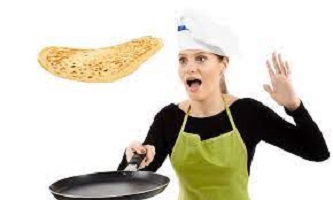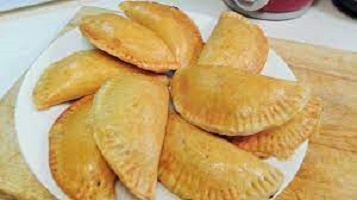Flipping Pancakes: How to Flip a Pancake (When & How)
Flipping Pancakes: How to Flip a Pancake (When & How)

Pancakes – Flipping Pancakes are a tasty morning meal made from eggs, flour, milk, and butter.
Even though pancakes have been around for over 5,000 years, flipping one can be difficult. Flipping is simple and enjoyable if you employ the proper technique and pay attention to the pan.
Related Posts on Flipping Pancakes
- Eggless Pancake Recipe | Pancake without Eggs | Egg-Free Pancakes
- Nigeria Crepes Recipe: Pancakes Extra Thin
- Healthy Oatmeal Pancakes (Oat Pancakes) Recipe
- Kabalagala: Ugandan Banana and Cassava Flour Pancakes
- Leftover Mashed Potato Pancakes | Potato Pancakes
- How to Make Pancakes at Home in Nigeria: Step-by-Step Guide
Flipping Pancakes
Flipping up a stack of fluffy hot pancakes may be a delicious but difficult task. Many pancakes lose their ideal round shape following an unsuccessful attempt to flip them over.
With this article, you’re about to improve your far-from-perfect pancake-flipping skills once you learn the chef-approved method to know exactly when to flip a pancake.
What Exactly Are Pancakes (Flipping Pancakes Meaning)?
Pancakes, also known as hotcakes, griddle cakes, or flapjacks, are a type of flat cake that is often baked with flour, butter, eggs, and sugar and topped with fruits, extra butter, and syrup.
It was traditionally made from scratch, although it can now be made with store-bought or homemade pancake mix.
How to Flip a Pancake – Flipping Pancakes
Using a Spatula to Flip Pancake
- Allow the edges to turn brown and the top to bubble before serving. When the edges of the pancake begin to crisp up and the top begins to bubble, it’s time to flip it.
- Keep an eye on your pancake to observe when this happens.
If you keep burning your pancakes, turn down the heat when you make the next one.
When frying your pancake, don’t use too much butter or oil or it will spew and burn you.
- Lift an edge of the pancake to check for a golden brown underside. Before flipping the pancake, the underside should be golden brown.
- You can test this by carefully lifting an edge of the pancake with a spatula or fork. The bottom should now feel more substantial, rather than batter-like.
To prevent your pancake from sticking to the pan, use a nonstick pan, nonstick cooking spray, butter, or oil.
- Make an attempt to get your spatula into the center of the pancake.
Cover as much of your spatula as possible with the underside of the pancake.
Lift it so that it clears the rim of the pan and prepare to flip it.
Holding it in the air for too long will cause it to break. You should make a swift transition to the flip.
- Quickly rotate your wrist 180 degrees to one side, causing the pancake to flip over. Turn your wrist over while holding the spatula with a fast flicking motion.
- The more you wait and the more you ponder, the more likely it is that the pancake will break. Carry it out fast and confidently.
If you make a mistake, scrape the pancake and start over.
Make sure to just flip the pancake once.
It will become tough and chewy after multiple flips.
Making Use of the Pan to Flip Pancake – Flipping Pancakes
- For flipping, use a lighter pan. For this method of flipping pancakes, a hefty cast iron pan may be more difficult to use than a lighter pan.
- Because you’ll be using two hands for this technique, keep the weight of the pan in mind.
A pan with a higher lip on the sides will be more convenient to use.
- Shake the pan and wait for the pancake to slide around. If your pancake slides around when you shake your skillet, it’s time to flip it. When flipping without a spatula, it’s critical to ensure that your pancake doesn’t become caught.
When checking on your pancake, give it a gentle shake.
If you’re not sure, you can check the underside with a fork.
- Lift the pan 3 inches in the air with both hands and tilt it slightly forward. The pancake should be resting on the pan’s rim but not sliding out of it. The pancake is not ready to be flipped if it does not move and is stuck to the pan.
- Quickly flick your wrists upwards to flip your pancake. When you flick your wrist upward, follow through with confidence. The pancake should flip towards you and land on the other side.
- Cook the pancake only once on each side. The more you turn it, the tougher the pancake becomes.
How to Stop Pancakes from Sticking – Flipping Pancakes
Before we get into when to flip pancakes, let’s discuss how to keep pancakes from sticking. To accomplish this, follow the advice provided below.
Choosing the Correct Pan
It is preferable to use a nonstick griddle or a high-quality stainless steel pan.
Grease the griddle as follows: Spray the griddle with oil spray and allow it to heat up. The heat prevents the pancake batter from sticking.
If you are using butter to grease the griddle, you must work fast so that the butter does not burn.
When the griddle is heated, add the butter, then the batter, and cook.
Timing: Flipping pancakes at the proper time prevents them from sticking.
When Should Pancakes Be Flipped?
When is the optimum moment to flip those pancakes? The pancakes themselves will provide you with hints!
As the pancakes cook, you will notice bubbles forming in the batter – do not flip yet.
Bubbles pop – It’s time to flip once the bubbles have popped and there are holes in the batter. That takes about 4 minutes for most pancakes.
Pancakes should not cling together – The Flipping Pancakes
Another sign that the pancake is ready to flip is if it does not adhere to the pan.
Put your spatula gently beneath the side of a pancake; if it easily lifts up, it’s done. If not, simmer it for a little longer.
Finish the cooking
Cook for 2 to 3 minutes on the second side, or until it’s a lovely golden brown
How much time does it take to cook pancakes on each side?
The amount of time it takes to cook pancakes on each side varies depending on the ingredients. Cook them for longer on the first side than the second.
In general, pancakes should be cooked for 4 minutes on the first side and 2 to 3 minutes on the second.
Pancake Recipe for Flipping Pancakes
- 1 ¼ cups of flour
- 1/3 cup of brown sugar
- 2 eggs
- 1 cup of milk
- 2 teaspoons of baking powder
- 4 spoons of oil
- ¼ teaspoons of vanilla extract
Mix all ingredients together and fry
Recipes for Pancakes from Other Readers
You are now a Pancake Flipping Pro now that you know when and how to flip pancakes.
Here are some pancake recipes to demonstrate your culinary prowess:
- Lemon Blueberry Pancakes
- Bacon Pancakes
- Pumpkin Pancakes
- Fluffy Buttermilk Pancakes
People also ask about Flipping Pancakes
Is it necessary to flip pancakes?
When you observe bubbles on the surface of the pancake, don’t flip it; instead, flip it when the bubbles pop and produce holes that stay open.
Hold off on flipping if a bubble rises to the surface pops, and is quickly filled in by more pancake batter. Make sure your pancakes have a lot of holes in them!
How long do you wait before flipping a pancake?
For around 10 minutes, heat the pan on medium. Pour the batter into the pan to make pancakes of any size.
Cook for three minutes on the first side, until bubbles, appear on top; then flip and cook for another two minutes on the other side.
Serve immediately with butter and maple syrup, or keep warm in the oven for a few minutes.
Why do pancakes in restaurants taste better?
Restaurant pancakes taste better because they are cooked on a professional griddle, which produces a crispier and more evenly cooked product than you can get at home.
Why am I unable to flip my pancakes? Flipping Pancakes
Alternatively, you could be turning too soon. Wait for those bubbles to develop on the surface of the pancakes, as they indicate that not only has the bottom layer of the pancakes cooked but that the uncooked side is beginning to firm up as well, ensuring that the pancakes will not break apart when flipped.
This could also be a heat issue.
What happens if you make pancakes using milk instead of water?
Milk fat is required for supple, moist pancakes, as well as adding flavor. Water alone will not produce the same results.
For a thicker thickness, milk can be used for water in the “complete” mixtures.
My pancakes aren’t sticking together for some reason.
When pancakes fall apart, it’s usually because a vital ingredient is missing or the recipe’s component ratios are incorrect.
Often, the problem is that there isn’t enough egg or none at all. Also, while adding ingredients, make sure you use precise measurements.
Without a spatula, how do you flip a pancake? The Flipping Pancakes
For flipping, use a lighter pan.
Wait until the pancake moves around the pan after shaking it.
Lift the pan 3 inches in the air and tilt it gently forward using both hands.
Flick your wrists forward in a quick upward motion to flip your pancake.
What component prevents pancakes from crumbling?
The addition of eggs to the batter helps it stick together and keeps the pancakes moist. Egg whites can be used in place of eggs in a two-to-one ratio.
Is it possible to overmix pancake batter?
Just avoid making the most typical pancake blunder of over-mixing your batter! It only takes a few wrists turns to make perfectly fluffy pancakes.
Over mixing is a baker’s worst enemy. Too much stirring can transform normally tender and soaring pancakes into harsh, flat disappointments.
What’s the best way to fix gooey pancakes?
“Gluten expands and makes the pancakes sticky when the batter is overmixed.” What to do about it:
“When mixing the batter together, gently fold in the ingredients. It makes the pancakes lighter and fluffier “Vizethann explains.
Why are the insides of my pancakes so mushy?
Turning up the heat too much
High heat does not cook pancakes faster; instead, it causes them to cook unevenly and with charred edges.
The pan must be hot, but if you set it too high, the bottoms will burn while the middle will stay uncooked and doughy.
Why is it that the second batch of pancakes always tastes better than the first?
While the first pancake cooks, the pan heat up and absorbs just enough fat from the cooking surface to allow the second to cook


